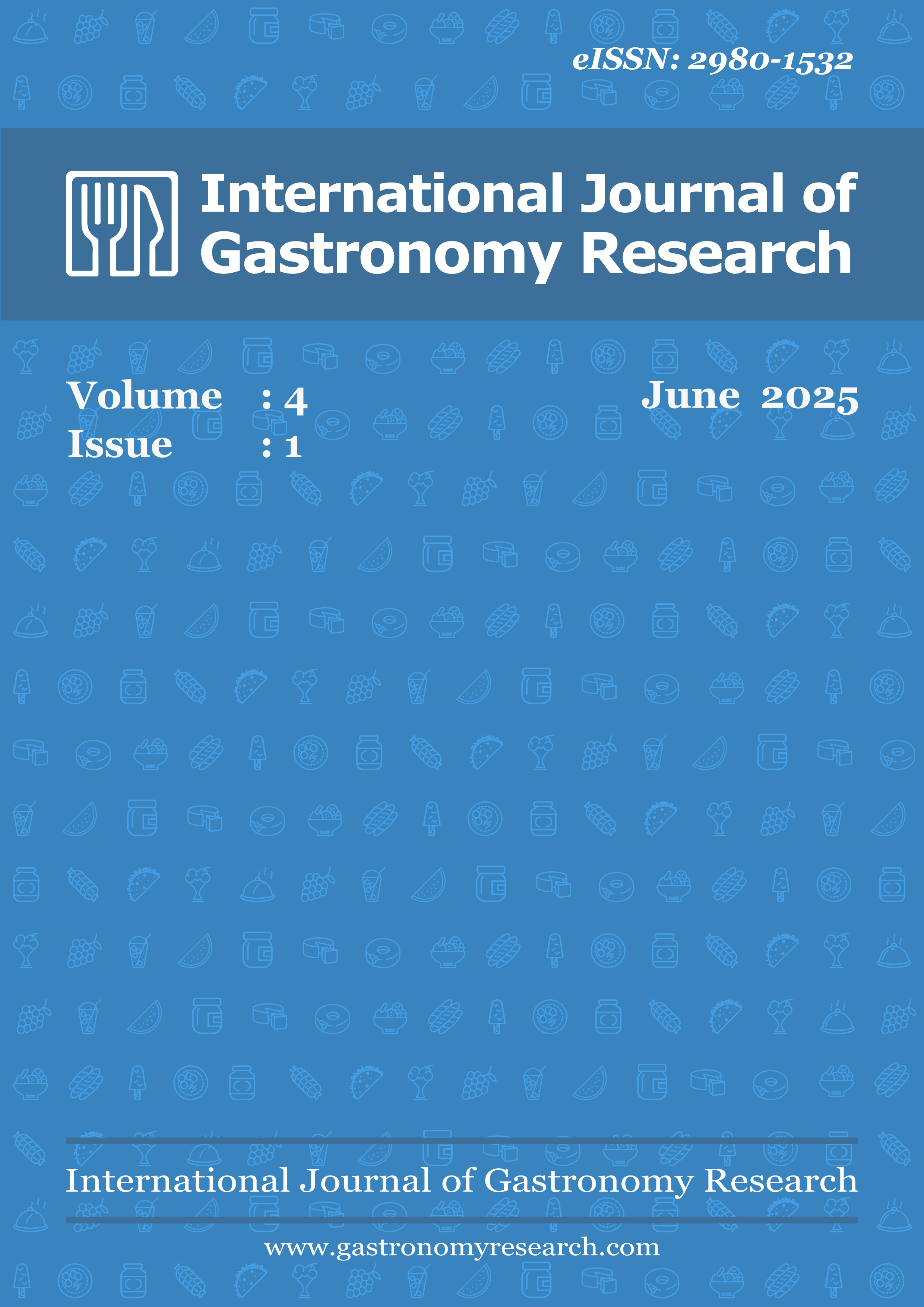Physicochemical and Microbiological Properties of Different Kayseri Pastirma Types
DOI:
https://doi.org/10.56479/ijgr-45Keywords:
Kayseri pastirma, pastirma, Kayseri, Microbiological characteristicsAbstract
In this study, a total of 20 pastirma samples were collected from the Kayseri local market, and their physicochemical (moisture, pH) and microbiological (lactic acid bacteria, total yeast-mold, total mesophilic aerobic bacteria) properties were investigated. Moisture and pH values of samples ranged from 34.77 to 57.61% and 5.81 to 6.22, respectively. While LAB counts of samples ranged from <2 to 5.61 log CFU/g, TMAB counts were found between 3.89 and 8.60 log CFU/g. Yeast counts were highest in the P9 sample, while mold counts were highest in the P11 sample. In conclusion, these pastirma samples exhibited significant variability in the physicochemical and microbiological properties due to differences in sample type and production conditions. Furthermore, the use of different culture media led to variations in yeast and mold counts, highlighting the critical role of media selection in accurately assessing the microbiological characteristics of pastirma.
Downloads
References
Aksu, M.İ., & Kaya, M. (2001). Pastırma üretiminde starter kültür kullanımının son ürün özellikleri üzerine etkisi. Turkish Journal of Veterinary and Animal Science, 25, 847-854.
Aksu, M.İ., & Kaya, M. (2002). Potasyum nitrat ve starter kültür kullanılarak üretilen pastırmaların bazı mikrobiyolojik ve kimyasal özellikleri. Turkish Journal of Veterinary and Animal Science, 26, 125-132
Aktaş, N., Aksu, M.İ., & Kaya, M. (2005). Changes in myofibriller proteins during processing of Pastırma (Turkish dry meat product) produced with commercial starter cultures. Food Chemistry, 90, 649-654. DOI: https://doi.org/10.1016/j.foodchem.2004.04.025
Çakıcı, N. (2012). Sırt, bohça, şekerpare ve kuşgömü pastirma çeşitlerinin kalite özellikleri [Unpublished master’s thesis]. Atatürk University.
Çakıcı, N., Aksu, M.İ., & Erdemir, E. (2015). A survey of the physico-chemical and microbiological quality of different pastırma types:a dry-cured meat product. CyTA - Journal of Food, 13, 196-203. DOI: https://doi.org/10.1080/19476337.2014.938123
Ceylan, S., & Aksu, M.İ. (2011). Free Amino Acids Profile and Quantities of ‘Sırt’, ‘Bohca’ and ‘Sekerpare’ Pastirma, Dry Cured Meat Products. Journal of the Science of Food and Agriculture, 91, 956-962. DOI: https://doi.org/10.1002/jsfa.4273
Ceylan, S. (2009). Bazı pastirma çeşitlerinin (sirt, bohça, şekerpare) serbest amino asit kompozisyonu. [Unpublished master’s thesis]. Atatürk University.
Doğruer, Y., Gürbüz, U., & Nizamoğlu, M. (1995). Konya’da tüketime sunulan pastirmalarin kalitesi. Veteriner Bilimleri Dergisi, 11(2), 77-81.
Elmalı, M., Yaman, H., Ulukanlı, Z., & Tekinşen, K. (2007). Microbiological and Some Chemical Features of the Pastrami Sold in Turkey. Medycyna Weterynaryjna, 63(8), 931-934.
Gökalp, H.Y., Kaya, M., & Zorba, Ö. (1994). Et Ürünleri İşleme Mühendisliği. Atatürk University Publishing.
Gürbüz, Ü. (1994). Pastırma üretiminde değişik tuzlama tekniklerinin uygulanmasi ve kaliteye etkileri [Unpublished doctoral dissertation]. Selçuk University.
Hastaoğlu, E. (2011). Potasyum klorür kullaniminin pastirmanin bazi kalite özellikleri üzerine etkileri [Unpublished master’s thesis]. Hacettepe University.
Kaban, G. (2009). Changes in the composition of volatile compounds and in microbio- Logical and physicochemical parameters during pastırma processing. Meat Science, 82, 112-116. DOI: https://doi.org/10.1016/j.meatsci.2008.11.017
Kaya, M., & Kaban, G. (2010). Fermente et ürünleri. In N. Aran (Ed.), Gıda Biyoteknolojisi (pp. 157–190). Nobel Yayın.
Leistner, L. (1988). Hurden-TechnoLogie bei Fleischerzeugnissen und anderen Lebensmitteln. Lebensmittelqualitat Wissenchaft und Technik. In R. Stufe (Ed.), Wissenschaftliche Arbeitstagung 25 JahreInstitut fur Forschung und Entwicklung der Maizena Ges. MbH, (pp. 323-340), Heilbornn.
Özdemir, H., Sireli, U.T., Sarıahmetoglu, B., & Inat, G. (1999). Ankara'da tüketime sunulan pastırmalarda mikrobiyal floranın incelenmesi. Turkish Journal of Veterinary and Animal Sciences, 23, 57-62.
Özeren, T. (1980). Pastırmanın olgunlaştırılması sırasında mikroflora ve bazı kimyasal niteliklerinde meydana gelen değişiklikler üzerinde incelemeler [Unpublished doctoral dissertation]. Ankara University.
Ozturk, I. (2015). Presence, changes and technological properties of yeast species during processing of pastirma, a Turkish dry-cured meat product. Food Control, 50, 76-84. DOI: https://doi.org/10.1016/j.foodcont.2014.08.039
Tekinşen, O.C., & Doğruer, Y. (2000). Her yönü ile pastırma. Selçuk University Publishing.
Türk Gıda Kodeksi Et ve Et Ürünleri Tebliği (2012) Tebliğ No: 2012/74. http://www.mevzuat.gov.tr/Metin.Aspx?MevzuatKod=9.5.16821&MevzuatIliski=0&sourceXmlSearch=et%20%C3%BCr%C3%BCnleri
TSE [Türk Standardları Enstitüsü] (1991). Pastırma Yapım Kuralları. Standard No: 9268.
Yetim, H., Sagdic, O., Dogan, M., & Ockerman, H.W. (2006). Sensitivity of three pathogenic bacteria to Turkish cemen paste and its ingredients. Meat Science, 74(2), 354-358. DOI: https://doi.org/10.1016/j.meatsci.2006.04.001
Downloads
Published
How to Cite
Issue
Section
License
Copyright (c) 2025 Cansu Ceviker, Cansu Karakose, Gizem Kahraman, Nagihan Aydin, İsmet Öztürk

This work is licensed under a Creative Commons Attribution-NonCommercial 4.0 International License.
Licensing (CC BY-NC 4.0): This license allows others to remix, adapt, and build upon the work for non-commercial purposes, provided that appropriate credit is given to IJGR. Authors may also share their complete publications freely, without any restrictions.









